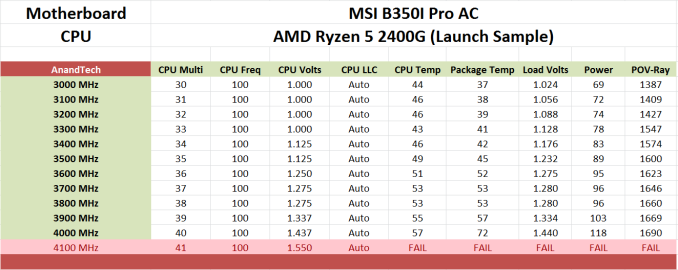I've seen you mention this a few times and I'm having difficulty understanding how you can state so? I saw the equations you put out in some thread, but you can hardly just toss out an equation that is able to point out real world power scaling characteristics of all chips, regardless of where they are at their power curve. You seem to think all chips behave the same way? That is not the case at all. Here for example is an AMD APU tested by Anandtech with different clock rates/voltages and the resulting power consumption. You can see the power scaling is very different to what your equation would state.
https://www.anandtech.com/show/12542/overclocking-the-amd-ryzen-apus-guide-results/7
The formula includes a set amount of power draw as well, Po. If we are looking at total power, and include numbers we must calculate holistically.
Total power = Po + Pv
I don't know what Po is as it is the amount of minimal power to keep the chip running before you engage in actual activity. So basically, just keep it 'on'.
And Pv = CV^2fa
In this exercise, C, a are going to stay constant.
With frequency varying proportionally with V.
so Pv = f^3
no, not that far off actually.
3000 Mhz vs 4000 Mhz
that's 4/3
(4/3)^3
= 2.37 times more power.
So if I account for 30 cores, lets say the minimum power to keep each core active is 1W.
So it's really 30*(1W) + 39W @ 3000 Mhz. = 69W
Lets look at the variable now for 4000Mhz:
39W * 2.37 = 92.43W
Go back to our equation here
Po + Pv = Total power
30W + 92.43W = 122.43W
Not all that far off from 118W
That's not accounting for any other forms of power redistribution.
So I chose 30 just because. I really don't know what the 'Po' voltage is for each core. But it's likely a little higher than 1W. They say idle power is 18.9W (honestly I'm not sure where the power savings are, if they are shutting down idle etc) but it has 4 cores. So an idle wattage of nearly 4.725W per core.
A Ryzen 3600 is 51W idle with 8 cores. So 6.375W.
I'll try to plug in 4.725W per core
4*4.725W + 50.1*2.67 = 152.667W
Not all that far from the mark. I suspect Po is higher per core, but on idle they may be shutting down a lot of transistors.


